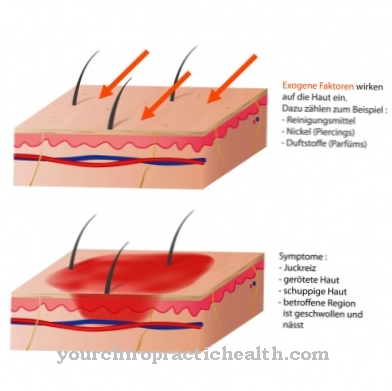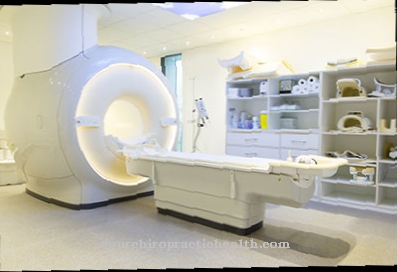The Frontal sinusitis is an inflammation of the frontal sinus. It is a form of sinus infection.
What is frontal sinusitis?

© Peter Hermes Furian - stock.adobe.com
At a Frontal sinusitis the frontal sinus is inflamed. The frontal sinus is a paranasal sinus. Inflammation of a sinus is called sinusitis. The frontal sinus is called the frontal sinus in Latin, so that the inflammation of the frontal sinus is called frontal sinusitis in medical terminology.
If you have a sinus infection, the lining of the sinuses is inflamed. Normally the lining of the nose is also inflamed. A combination of inflammation of the nose and inflammation of the sinuses is called rhinosinusitis.The two frontal sinuses are directly above the nose above the eyebrows. Frontal sinusitis therefore leads to headaches in the forehead area.
The inflammation of the frontal sinus can occur in isolation or in combination with inflammation of the other sinuses. Most often the maxillary sinuses are inflamed. Ethmoid cell inflammation is also quite common. Isolated frontal sinusitis is less common.
In the case of frontal sinusitis, a distinction can be made between an acute and a chronic form. The acute sinus infection lasts a maximum of two weeks. After this time the symptoms have completely disappeared. If the disease lasts longer than two weeks or if symptoms remain, it is chronic frontal sinusitis.
causes
Acute suppuration of the frontal sinus usually develops from a cold (rhinitis). The swelling of the mucous membranes in the nose prevents the discharge of secretions from the frontal sinus. Only 20 to 30 percent of all sinus infections are caused by bacteria. The majority is caused by viruses.
However, once viral sinusitis has developed, pathogens such as Haemophilus infulenzae B, pneumococci or ß-hemolytic streptococci of group A tend to cause a second bacterial infection. An allergy can also cause frontal sinusitis. Chronic frontal sinusitis usually results from an acute sinus infection that has not healed.
Various factors can help frontal sinusitis develop more quickly. Possible risk factors are a weakened immune system and anatomical features such as enlarged turbinates, narrowed entrances to the sinuses and a bent nasal septum.
Symptoms, ailments & signs
The main symptom of acute sinusitis is headache. These are accompanied by a strong feeling of pressure in the front of the head. The pain worsens as soon as people tilt their heads forward. Shocks, such as jumping or stepping firmly with one foot, make the pain worse. Often the pain is throbbing right above the eyebrows.
If the frontal sinus infection occurs in combination with an inflammation of the maxillary sinus, toothache can also develop. With simultaneous rhinitis, a purulent yellowish-green nasal discharge develops. Nasal breathing is impeded and a so-called "mucus road" forms in the throat. This is caused by the constant flow of secretions from the sinuses. The secretion cannot flow out through the nose and therefore runs down the throat.
Severe inflammation is accompanied by fever, blurred vision, and fatigue. A strong cough can also result from the expelling mucus in the airways. If the urge to cough for a long time, pain in the chest muscles occurs. Chronic sinusitis is characterized by a loss of performance and chronic fatigue.
In advanced stages, drowsiness up to delirium can develop. Frontal sinusitis is usually not associated with nosebleeds. Increased nosebleeds should always be taken as an indication of a malignant neoplasm in the area of the paranasal sinuses.
Diagnosis & course of disease
The diagnosis can easily be made with an endoscopic examination. The very clear symptoms of sinusitis usually provide the decisive clues. Imaging procedures such as sonography or magnetic resonance tomography can be used to clarify chronic sinusitis.
Complications
Frontal sinusitis can cause various complications. Occasionally, for example, abscesses form in the area of the upper eyelid or purulent inflammation of the eye socket occurs. If the course is severe, life-threatening meningitis and brain abscesses can develop. If the forehead skin inflammation is not or only insufficiently treated, it can develop into a chronic disease.
As a result, smell and taste disorders can occur. Some patients suffer from acute flare-ups that are accompanied by pain and exhaustion. Typical symptoms such as fever or cough can also result in serious complications, such as circulatory problems and shortness of breath. In the advanced stages of the disease, persistent drowsiness and even delirium can occur.
Increased nosebleeds suggests that the inflammation has spread to the sinuses. If medication is prescribed as part of the therapy, various side effects and interactions can occur. The use of decongestant nasal sprays or nasal drops can cause irritation of the mucous membrane or even lead to dependence.
Antibiotics and expectorants sometimes cause symptoms such as gastrointestinal problems, headaches or allergic reactions. Heart, liver and kidney damage cannot be ruled out with prolonged use.
When should you go to the doctor?
Sinusitis is not always a reason to see a doctor. Often it arises from a bacterial infection and heals spontaneously with it. However, there are cases that make it necessary to see a doctor. This can be the aim of the initial diagnosis of the disease as well as the treatment of chronic sinusitis or a clinical picture with particularly severe symptoms. In this case, the contact person is the family doctor or the specialist in ear, nose and throat medicine.
Frontal sinusitis requires a visit to the doctor, especially if you experience pressing headaches over the eye area in connection with a cold or a cold simply does not want to heal. On the one hand, the doctor determines that the headache is caused by a frontal sinus infection and not by some other process. On the other hand, the aim is to prevent an acute illness from taking a chronic course, which in certain circumstances may then no longer be so easy to treat.
Even patients prone to sinusitis can recognize the disease in advance by going to the doctor and prevent it from developing. This is particularly important for patients with multiple illnesses or for children who are repeatedly infected with bacterial infections through their stay in kindergarten and school.
Therapy & Treatment
The main goal of therapy is to reduce inflammation. The natural drainage of mucus in the nose and sinuses must be restored. Increased fluid intake through increased drinking liquefies the mucus and thus leads to improved excretion. The same effect is achieved through high humidity in the air we breathe, through short-wave treatment, through nasal rinsing or seawater sprays.
Steam inhalations with essential oils or plant extracts can also be helpful. Expectorants or expectorants such as acetylcysteine or ambroxol can be taken. There are also expectorant herbal supplements or enzyme supplements available for the treatment of frontal sinusitis.
The use of decongestant nasal sprays or nasal drops can help relieve symptoms. Since an addiction can develop quickly with these nasal sprays, the duration of use should be limited to one week. Medicines containing myrtol or cineol also ensure a clear nose.
The inflammation can be reduced by enzyme preparations or nasal sprays containing cortisone. Antibiotics are only indicated for very severe symptoms. In addition, a bacterial infection should be considered certain or at least likely. In severe cases, surgery may be required.
Shrinking the turbinate, scraping bones, straightening the nasal septum, or removing polyps can ease the obstructed mucus drainage. In the case of frontal sinusitis, strong heat and strong cold should be avoided. Temperature fluctuations make the pain worse. In the case of severe headaches, the head can be raised in bed using several pillows. This allows the secretion to drain away more easily.
prevention
Frontal sinusitis can only be prevented by strengthening the immune system. If you have a cold, the nose should only be blown with little pressure. Otherwise, bacteria can get into the sinuses due to the high pressure.
If the inflammation of the frontal sinus is due to benign mucosal growths or other anatomical conditions, these can be removed by surgery. This can prevent future inflammation.
Aftercare
In most cases, the direct follow-up measures for frontal sinusitis are significantly limited, although in some cases they are not even available to the person concerned. Therefore, the person affected with this disease should ideally consult a doctor very early and initiate treatment so that there are no further complaints or complications. This disease cannot heal itself, so treatment by a doctor is usually always necessary.
The earlier a doctor is contacted, the better the further course of the disease. In most cases, frontal sinusitis can be treated well with medication. The person affected should always observe the correct dosage and regular intake in order to permanently alleviate the symptoms.
When taking antibiotics, it should be noted that they must not be taken together with alcohol, otherwise their effect will be lessened. After the treatment, regular checks and examinations by a doctor are very useful. Frontal sinusitis does not usually reduce the life expectancy of those affected.
You can do that yourself
In the acute form, there is a strong forehead headache. One or both of the frontal sinuses are also sensitive to pressure and knocking. In this case, the doctor needs to check whether it is necessary to give antibiotics. Self-help measures are not recommended here. In this case it is better to see an ENT doctor.
Self-help options are only advisable in the case of chronic frontal sinusitis. Hydrotherapeutic measures include chamomile steam baths and warm soaring foot baths. Steam inhalations with essential oils from spruce, lavender and eucalyptus are soothing and beneficial. A good self-help measure is the addition of essential oils to the bath water. To do this, five to eight drops of peppermint oil are added to the bath water along with the same amount of lemon and lavender oil. Rubbing in with one of the oils mentioned is also helpful, mixed with 60 ml of a suitable carrier lotion for the face. Before going to bed, sufferers rub the cheekbones from the nose to the temples and forehead.
Dry air should be avoided as it dries out the nasal and throat mucous membranes. Walks in the fresh air and a sufficient supply of fluids are suitable for supporting the function of the mucous membranes.
























.jpg)



